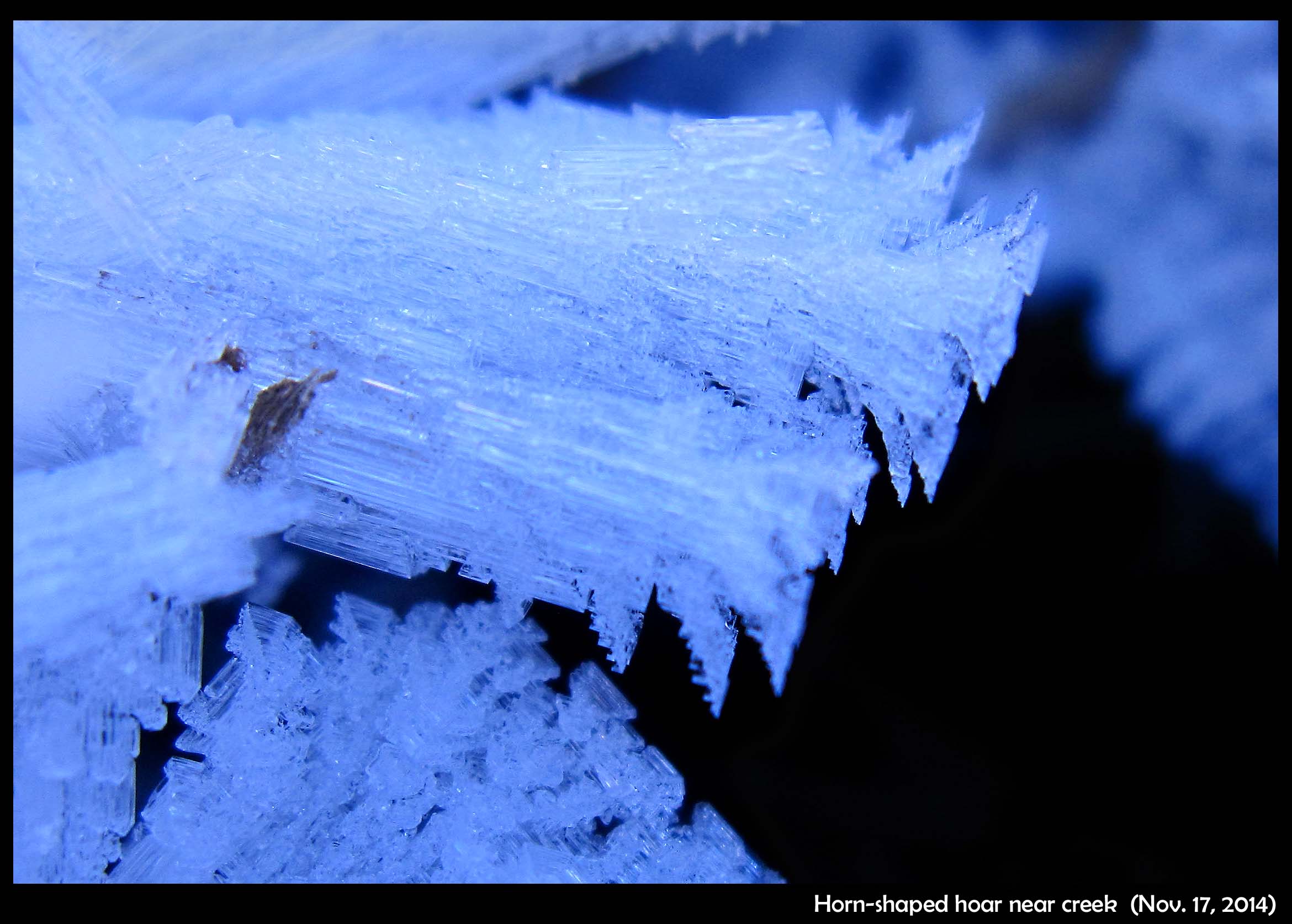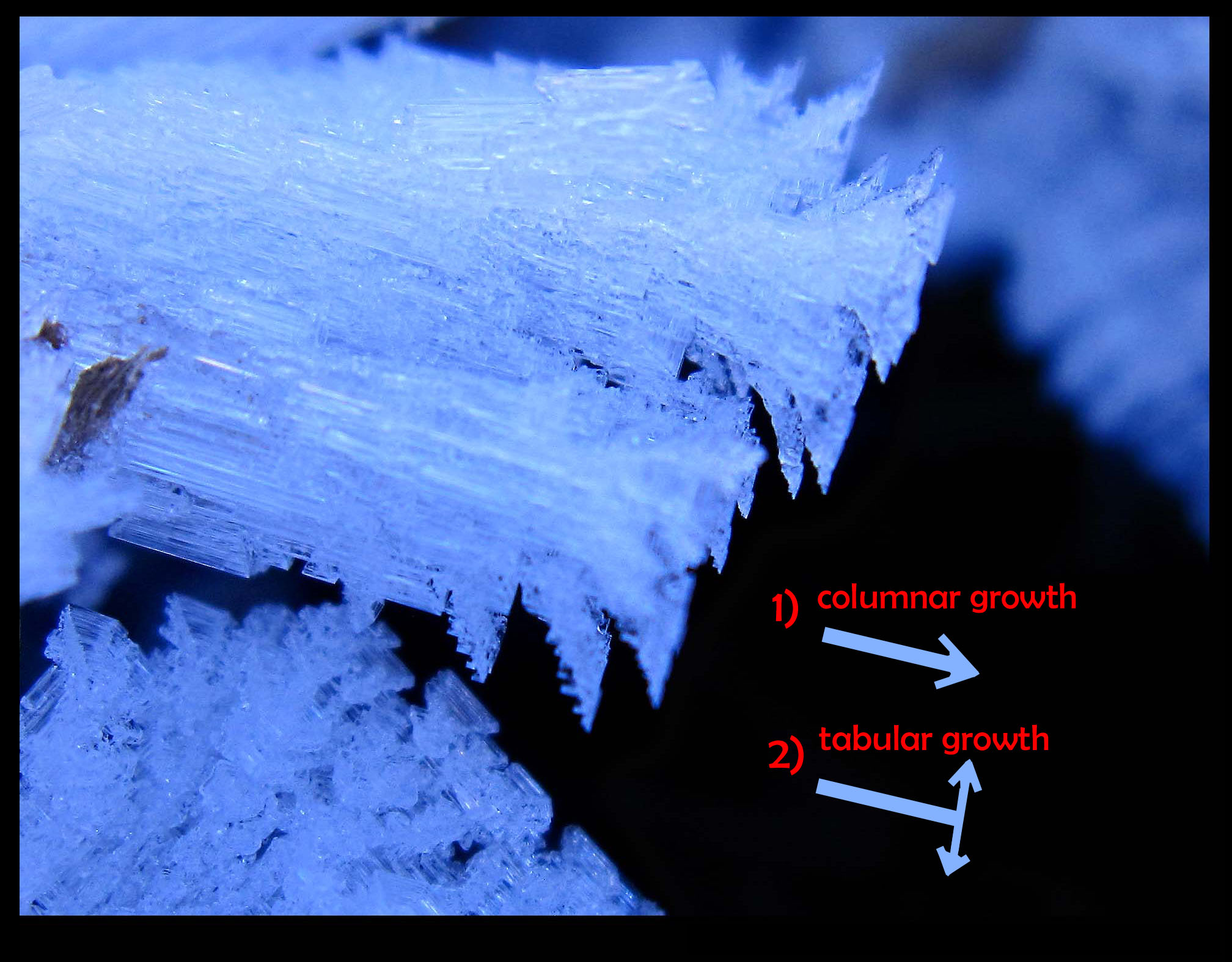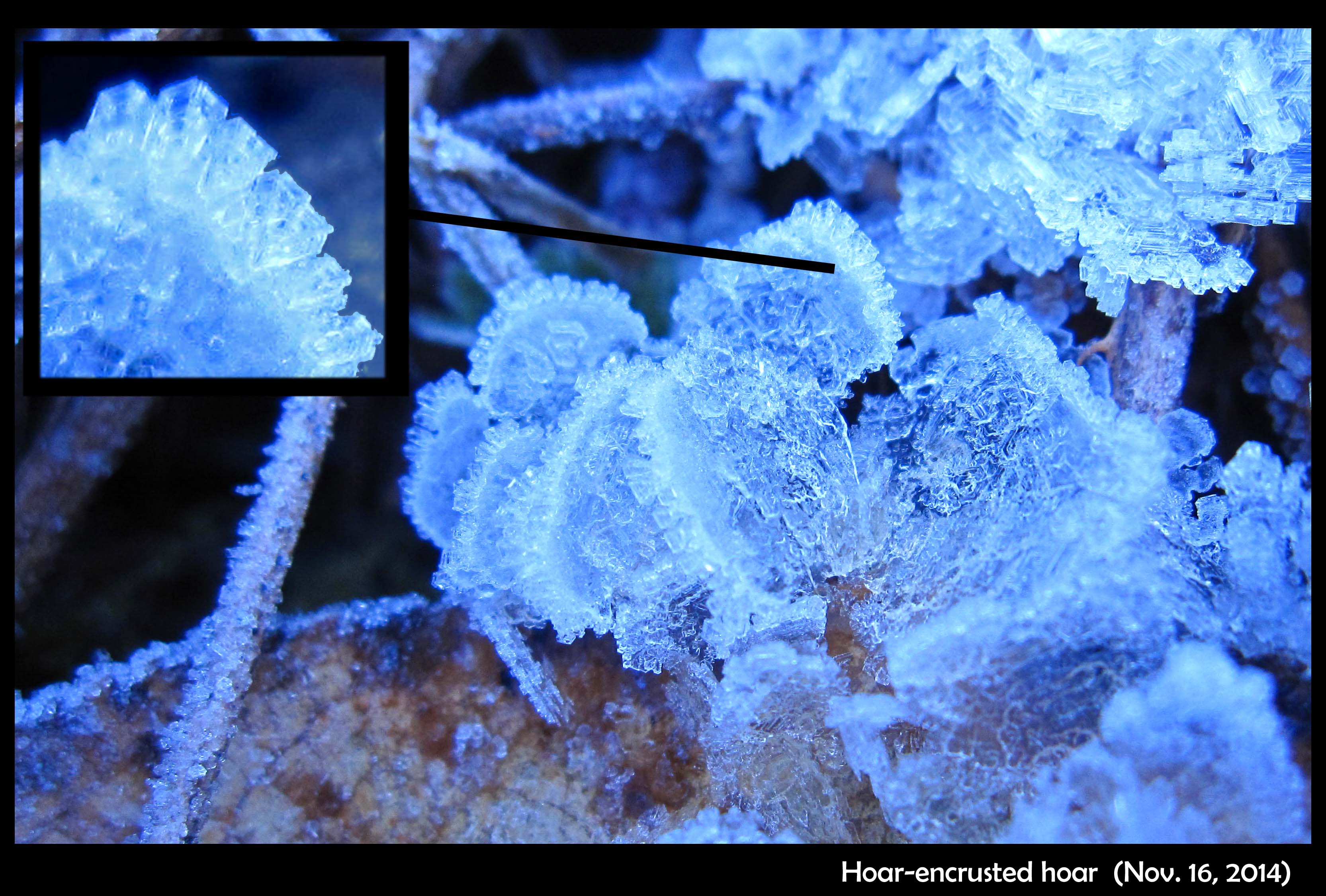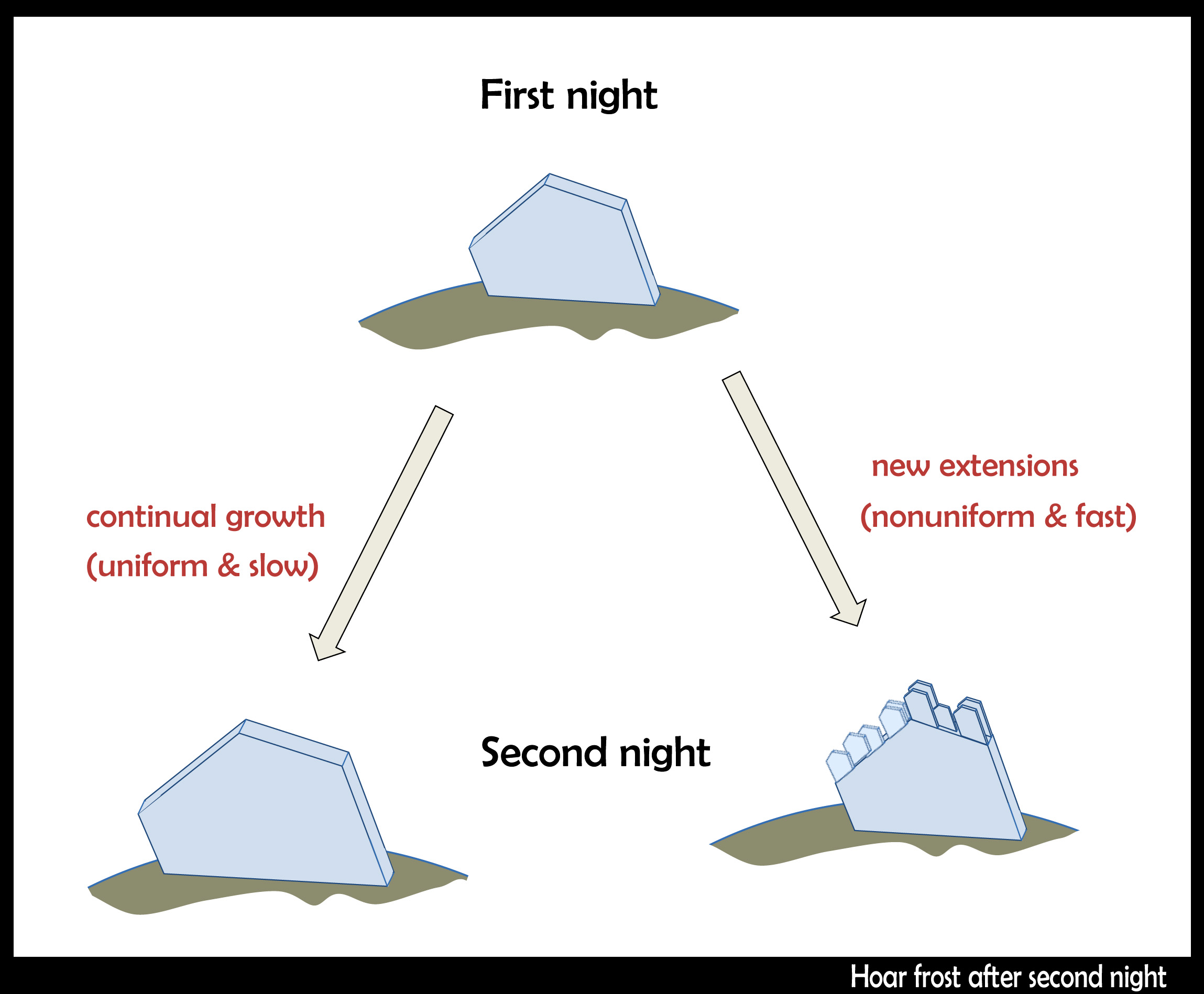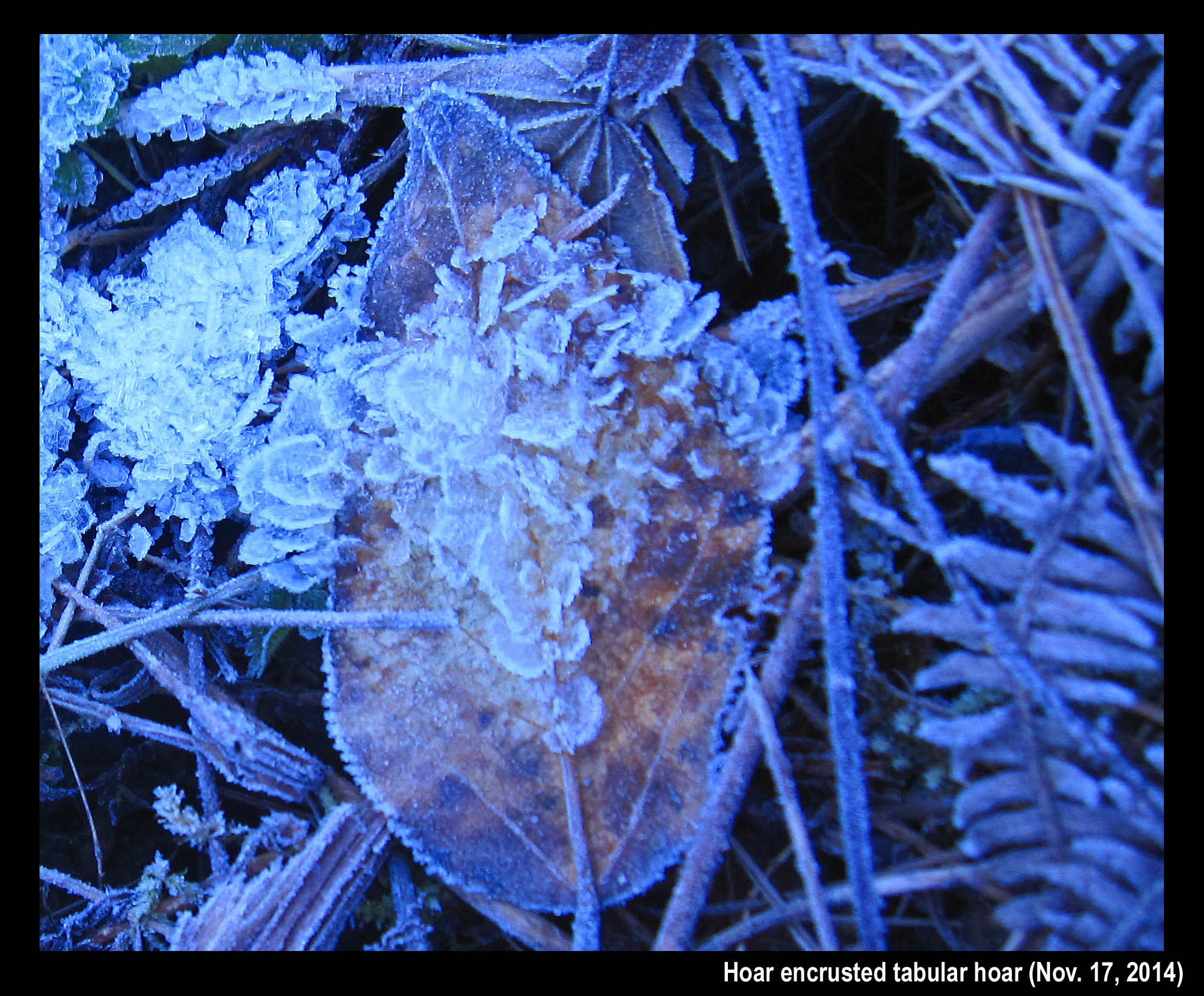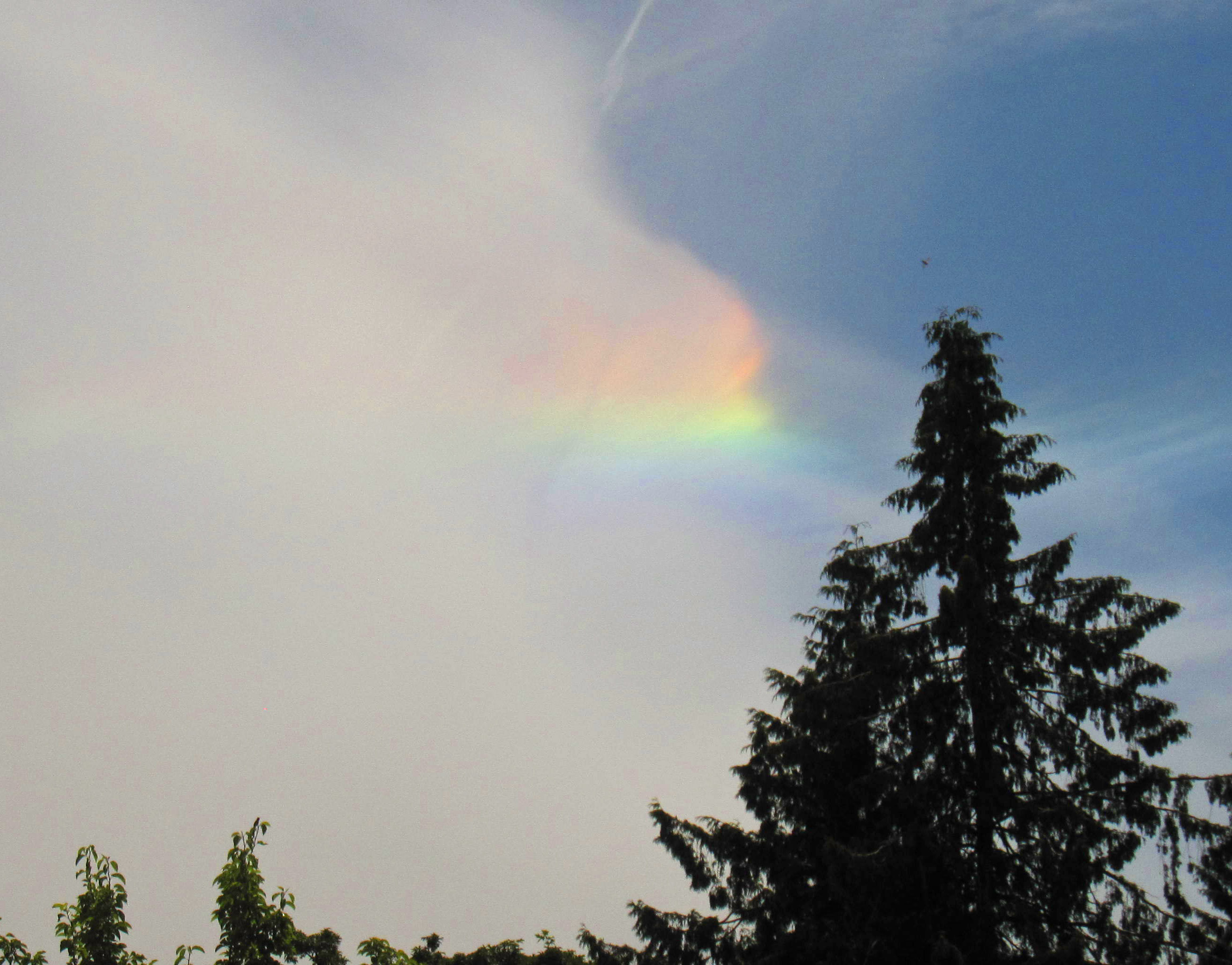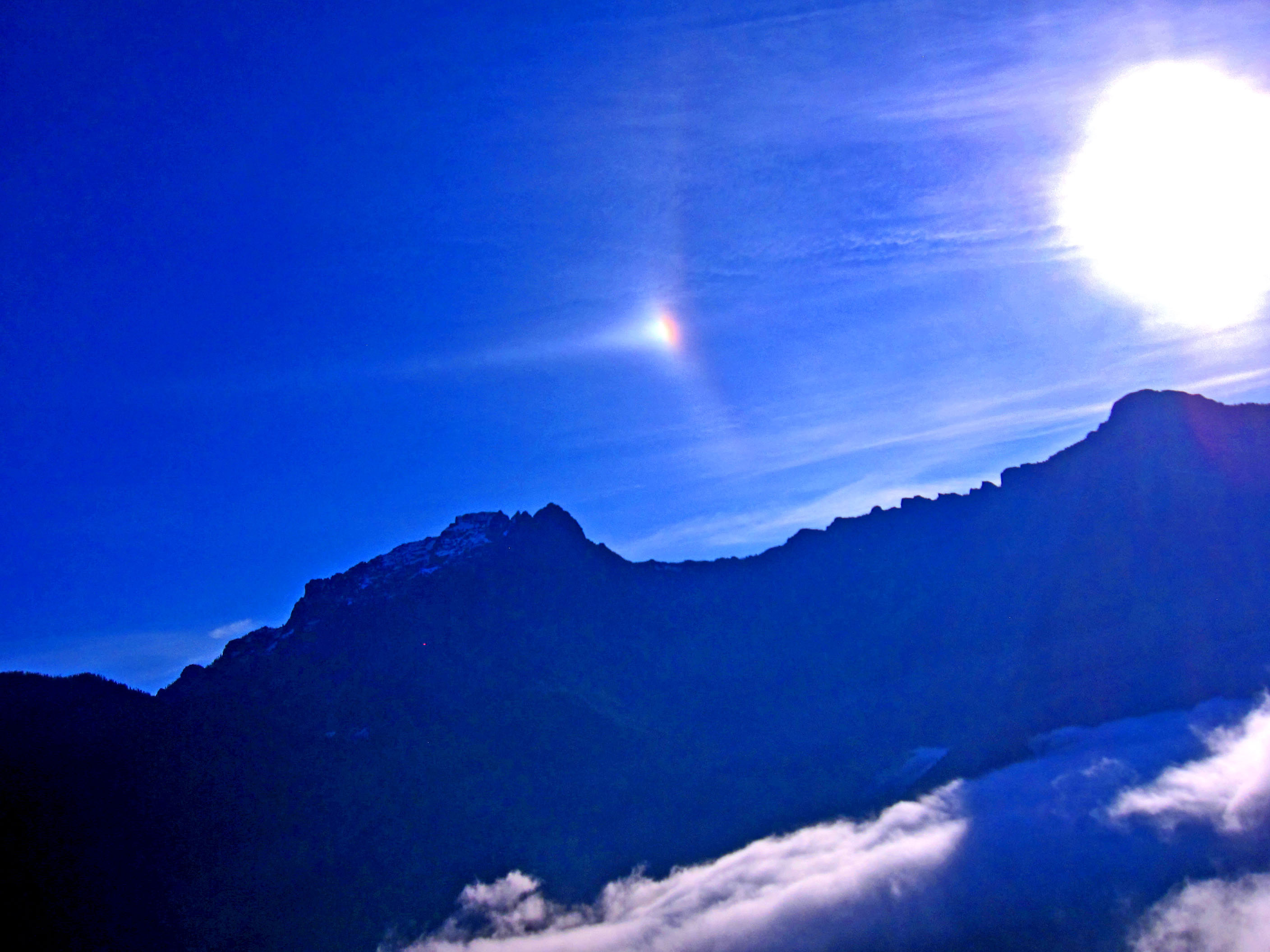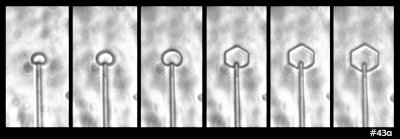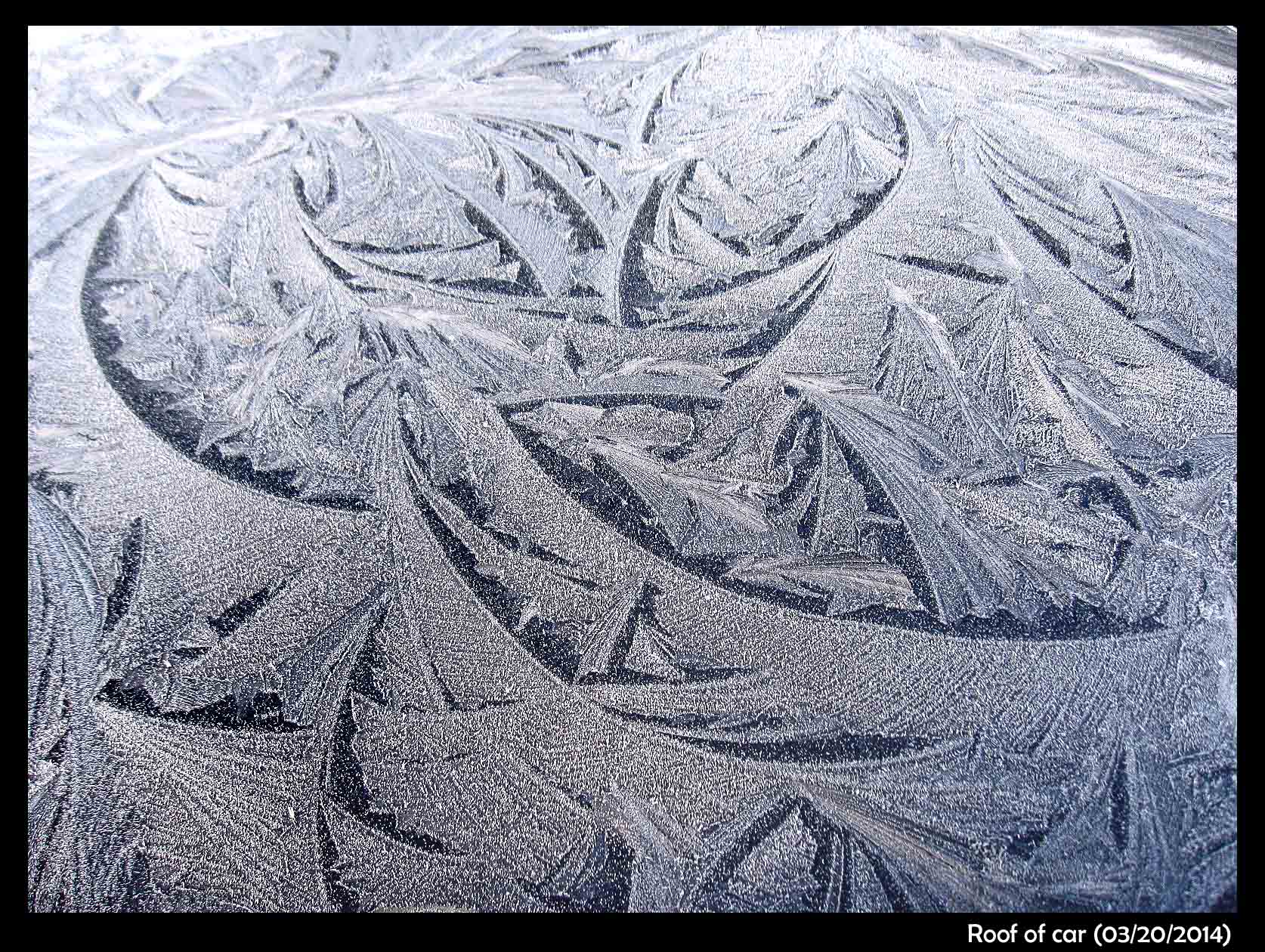A Change in Habit
November 23rd, 2014The two main growth modes of snow and hoar (i.e., ice growth from the vapor) are columnar and tabular. In columnar, the shape is long and thin, like a pencil or cluster of pencils (bound snugly with a rubber band). In tabular, the shape is plate-like or fan-like. When a crystal form has an easily expressed shape, like a column or plate, we say it has a certain habit.
In hoar frost that had been growing for several nights, I saw some that had changed their habit.
On the first night, when the vapor was more plentiful, large columnar forms appeared. This habit grows between -3 and -8 C. On a subsequent night, the temperature got colder, below -8 C, leading to tabular growth. More vapor exists out near the ends, so this is where we see the tabular habit.
The arrows above show the fast growth directions. There is a transition that sometimes happens when both of the main growth directions are fast, making a flare, or trumpet-horn shape (other times, it may be more of a cup or vase). Such a transition is far more common in hoar than in snow, because, I believe, hoar on the ground can experience a much higher excess of vapor.
The dark region in the background is the water of a creek.
--JN
Smaller Hoar Growing on Larger Hoar
November 22nd, 2014Cold air came down the interior, spilling through gaps in the Cascades, cooling the western side. In the Seattle area, we got our first frost on Nov. 11, but the days stayed cold. Areas in the shade never lost their hoar, so the hoar frost kept growing.
But does a hoar-frost crystal continue growing the same way as on the previous night? Does it keep extending uniformly, getting larger and larger, keeping the same general shape?
Or do smaller hoar crystals form on previously grown larger crystals?
A few days later, I found myself walking in Maple Falls near Mt. Baker. In a shady pocket near my feet, I saw some hoar. Subtly different -- it appeared like small, translucent leaves encrusted on their edges with hoarfrost. But it turned out that the "small leaves" were actually tabular hoar (plate-shaped). That is, hoar encrusted on hoar: smaller crystals on larger crystals.
When frost resumes growing on previously grown frost, the other possibility may also happen; that is, the hoar just resumes growing the way it did the previous night. But I think this is generally quite rare because it would require very slow and constant growth conditions, which is generally incompatible with the diurnal temperature cycle. See the sketch below for both possibilities.
Note that I write above 'smaller hoar crystals grow on the larger ones' even though technically, they are all the same crystal. You can see this is true by the fact that their faces all line up.
The view that got me to look closer:
- JN
New habit diagram for branched tabular crystals
August 24th, 2014You might call these “snowflakes”. But let's be specific here with the names.
Anyway, a close associate who has been sweating over his snow-crystal growth machine in Japan for many years has just published his latest results. His machine is a vertical supercooled-cloud wind tunnel, which is like a thin column of cloud in which one can observe a single floating crystal. The crystal is in a climate-controlled box containing a droplet-infused stream of uprising air.
For this study, he focused on the crystal habit (i.e., shape) in the temperature range that we tend to get the large six-pointed stars. In addition to varying the temperature, he varied the density of droplets in the air. Nobody had done this before, certainly not as carefully and complete as he. Though he found lots of interesting results, I'll focus here on the following diagram:
Given its similar layout to the well-known Nakaya habit diagram, let's call this the Takahashi habit diagram. Whereas Ukichiro Nakaya showed us the crystal shape as he varied the temperature and humidity, Prof. Tsuneya Takahashi varied the temperature and droplet density (“LWC” on the vertical axis stands for liquid water content).
The basic findings: As the temperature decreases from left to right in the diagram, the crystal form goes from the very wide-branched sector crystal (see the “sectors”?) to the longer branches of the broad-branch crystal, to the even longer and narrower branches of the stellar crystal, to the crystal with sidebranches on each branch, called a “dendrite”, and then the pattern reverses back to sectors.
In the middle of this temperature range, something else happens. If he increased the density of cloud droplets in the dendrite regime, he got the more finely sidebranched fern forms. Ferns differ from dendrites only in the number of sidebranches they have. Fern crystals look more like fern plants because they have more offshoots. But at other temperatures, adding more droplets did not change the crystal form. In fact, the crystal size did not increase with more droplets, although the mass did increase.
If you observe some crystal that looks similar to one on the Takahashi diagram, you may infer that it grew under the indicated conditions. But this is not yet the final story: for instance, the amount of sidebranching is also thought to depend upon the temperature and humidity fluctuations. More fun ahead!
- JN
It’s not a rainbow (it’s better)
August 12th, 2014In summer, the sun reaches higher elevations, bringing the possibility of new atmospheric displays. I saw this one in mid-June.
The top, upward arc is the more familiar and common 22-degree halo. But pay attention to the one on the bottom. Its colors look like a rainbow, but it has nothing to do with water drops of any sort.
It is the circumhorizontal arc, and it is as rare as it is beautiful. The colors are, in fact, more pure than those of the rainbow, and its origin is far more remarkable. It is remarkable because of the surprising set of conditions that must hold for it to exist. First of all, the particular region of cloud (at a certain angle to our eye) must consist mostly of ice crystals. Second, the crystals there must be nearly perfect tabular prisms. And third, these crystals must be in sufficiently non-turbulent air and of such a size that they fall in a nearly exact horizontal position:
The new ice-crystal-growth apparatus
July 1st, 2014After a few years in the making, our new device for growing single ice crystals in a well-controlled laboratory environment is nearly ready. We are just adding a few small accessory pieces to allow us to start testing. I was to describe the apparatus at the cloud-physics conference this month in Boston, and made a poster to present, but decided to opt out. But, having spent a few days making the poster, I present it below.
As with all images here, click on image to see large-scale view.
And below is the same, but in blog format.
Halo in the sky? Uh, I don't see no halo...
April 20th, 2014After a few days of fine bright spring weather, the barometer falls and a south wind begins to blow. High clouds, fragile and feathery, rise out of the west, the sky gradually becomes milky white, made opalescent by veils of cirro-stratus. The sun seems to shine through ground glass, its outline no longer sharp, but merging into its surroundings. There is a peculiar, uncertain light over the landscape; I 'feel' that there must be a halo round the sun!
And as a rule, I am right.
The quote, from Minneart* describes a common ice-related atmospheric apparition. It appears in skies all over the world far more often than the rainbow, yet few notice it. As a graduate student, I read about halos and often looked for one, but didn't notice it myself until someone else pointed it out. As a post-doc in Boulder, I was out walking with Charles Knight, and I mentioned my lack of success. He glanced up near the sun, pointed, and said “why there's one right now”.
What I had missed in my readings had been the fact that most halos are rather indistinct and often incomplete circles. Indeed, now when I point out the most common one (the 22-degree halo) to someone nearby, they often don't see it. But occasionally, it is sharp enough (and colored) to the extent that anyone will see it if they bother to look up and glance toward the sun. And often it occurs with other ice-crystal apparitions that are even more obvious.
Last fall, while perched high on a rock face, belaying my partner up**, I saw such a vivid display.
The bright spot is called a “sun dog”, “mock sun”, or “parhelia”. They, one on either side of the sun, usually appear together with the 22 degree halo. Indeed, the sun dogs very nearly mark the spots where that halo intersects another arc called the parahelic circle. Their cause: horizontally oriented, tabular ice crystals.
The fun of shooting down your own theories
April 10th, 2014Thomas H. Huxley once wrote the famous line:
The great tragedy of Science: the slaying of a beautiful hypothesis by an ugly fact.
Great man, catchy phrase, but perhaps a bit overdramatic. To me, the slaying of a “hypothesis” (i.e., pet theory or just idea, really) can be the beautiful thing. It means that one can do a lot of damage with just a simple observation. I like it, even when I'm shooting down my own theory. Here's an example:
Some time ago in my experiments, I saw the following ice growth sequence:
What you see there is an extremely small, thin ice crystal growing from the tip of a glass capillary into air. (Size-wise, the glass capillary is about 5 micro-meters in diameter, or about 1/10th the thickness of the hair on your head.) I saw it happen several times. As the crystal grew, it developed the prism facets that generally define the hexagonal crystal shape. Other people had seen such rounded growth before, generally within a few degrees of zero (C), though in all cases, the crystal had been extremely thin. You can also see this thin, rounded (non-facetted) form in some hoar-frost formations.
The mystery here is why the disk grows without the prism facets for awhile. I never saw this with thicker crystals, so I formed a little theory. The theory involves the source of the water molecules to the curved region of crystal: some come from the vapor in the air and some wander over from the flat, non-growing crystal faces on front and back. In the 1960s, people had tried to measure this “wandering distance”, but never determined a consistent value. My theory predicted that once the crystal thickness exceeded about twice this distance, the curved edge would transition to flat, giving rise to the hexagon.
But then I looked closely at this case:
That sequence shows the side and front view. The crystal doesn't discernibly thicken when the flat prism facets appear. Zing! That theory shot down.
On to the next pet theory. So maybe the key factor is the diameter of the disk: One might argue that the curvature of the crystal surface must be below a certain value, which means a large enough diameter is needed, for the flat facets to appear. Or, the size of the resulting prism faces must be larger than that needed to have several surface steps (which help ensure flatness).
But then I look at this case:
In that case, I see both smaller and larger prism faces forming at the same time (same thing can be seen in the previous image). So, I guess the curvature or size of the resulting face is not the main factor. Zing!
Some researchers had observed slight bending of the prism facet above -2.0 C in equilibrium. They postulated a “roughening temperature” at -2.0 C. This might explain the rounded disc edge, but wait! 1) This disc edge becomes facet as it grows, so it is not merely temperature, and 2) these crystals are below -2.0 C.
Zing again!
Well, there are always “impurities” to blame! Crystal growers are fond of blaming some trace, active chemical, or “impurity” for inexplicable results, so we could theorize that the above show the effect of surface impurities. As the crystal grows, the area over which the impurities distribute increases, thus diluting their concentration, and thus reducing their effect. Yes! This could explain these results.
But, wait, what about this:
The above shows two sequences (same capillary) in which some prism facets have formed, but some remain round. In the right-side case, one corner even rounds as it grows. Hmm, not a likely result of impurities. Zing!
So, I am down to one last theory. I do not yet have the data to shoot it down. And I'm not telling you, or I'd ruin the fun. We just need more data.
All in all, I think Huxley needs a little tweaking to serve my view:
The great beauty of science: the slaying of a pet idea by a simple observation.
-JN
Equinox frost I: Patterns on roof, hood, window, and mirror
March 24th, 2014Morning on the spring equinox, the first day of spring, brought a few gifts from winter. I) Film-frost, accentuated with hoar-frost on the cars.
See the white of the hoar, following a pattern set down by the thin layer of film-frost. The roof of one car:
And the roof of another:
So it went. As I walked through our parking area, I saw a different pattern on every car - a pattern that told a tale of the night's weather and evening conditions. The film frost here is dramatic because the water film was thick before it froze. And it was thick because it had been raining in the previous evening. Later that evening, the skies cleared, and the temperature dropped rapidly, ensuring that the thick film would freeze. And the warm wet weather of the previous day left plenty of vapor to deposit as hoar-frost.
Car hoods had their own story to tell:
Video of growing ice spike
March 6th, 2014Take about a cup of water, place in a glass flask, then plunge in liquid nitrogen. Watch.
">

What happens in that video is that the water starts to freeze from the bottom and sides of the flask, and the ice also spreads across the top surface. When the water turns to ice, it expands by about 10% and so the remaining water must be pushed aside. If a hole remains in the top ice layer, the water gets pushed out the top.
What happens next depends a lot on various, poorly studied features of the situation. But sometimes, the out-flowing water forms an ice spike like that shown above. Sometimes it doesn't. In a previous post (02/06/2011), I describe a vase-like shape that formed in an outdoor bathtub:
http://www.storyofsnow.com/admin.php?ctrl=items&blog=1&p=128
The trick of putting the flask in liquid nitrogen (about -200 C) came from Larry Wilen back in about 1989 when we were at the University of Washington. I later did the trick a few times at the University of Arizona, but I thought I'd try to perform it during a talk I gave in January, 2013. So, I went to see the chemistry-department demonstration guy, Eric Camp, at the UW, and we tried to replicate the demo. Now, in the past, I could get the spike pretty much every freeze, but Eric and I had the hardest time with it. So, in the end, I got the video, but didn't attempt the stunt at my talk.
- JN
The end of snow
March 1st, 2014This recent front-page article caught my eye:
The writer is an avid skier-snowboarder, and thus concerned about the future of his sport. The facts he relates paints a grim picture:
- In the past 47 years, a million square miles of spring snowcover has disappeared from the Northern Hemisphere.
- Since 1970, the winter warming-rate has been triple the rate of the previous 75 years.
- The Alps are warming 2-3 times faster than the world-wide average.
- Potential Winter Olympic venues shrinks from 19 (now) to 6 by 2100.
and many other facts. Avid skiers like spring skiing. For March, the data (from Rutgers University Global Snow Lab) show a decline in area covered by snow.
